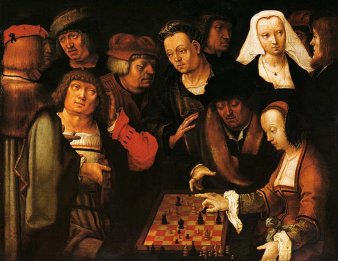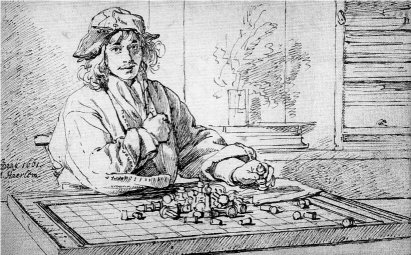Courier Chess
This Chess variant is one of the most known.
It has been played in some places of Germany, especially in
Ströbeck,
for a rather long period. Having appeared in Middle Age, it has
been remarked for its early introduction of a piece moving all
along the diagonals, like a forerunner of the modern Bishop.
Another reason for its celebrity is because it makes the center
subject of the Dutch painter Lucas van Leyden around 1508.
The Chess players, Lucas van Leyden (c. 1508)
DESCRIPTION:
The board has 12 columns and 8 raws, with checkered colors. The painting shows a white square at players' righ hand, whereas a conserved board at the Ströbeck Chess Museum has a black one. There were probably no firm rule for this point.
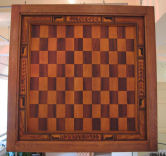
Board conserved in the Ströbeck Chess Museum
Every player has 24 men: 1 King, 1 Queen, 1 Sage or Counsellor (Mann, Ratgeber), 1 Jester or Spy (Schleich), 2 "Couriers" (Kurrier), 2 Archers (Schütze), 2 Knights, 2 Rooks and 12 Pawns.
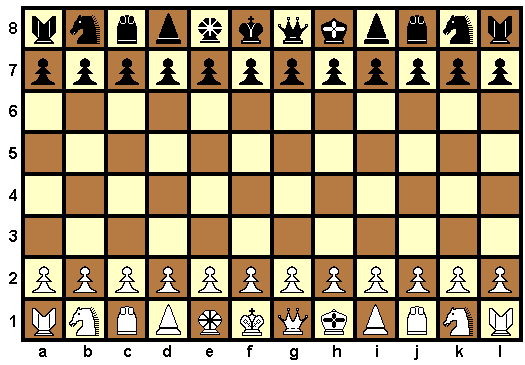
Conventional setup
RULES:
![]() King: moves 1 step in all 8 directions like the modern
King. The King could not make any jump at his first move. Castling
was ignored.
King: moves 1 step in all 8 directions like the modern
King. The King could not make any jump at his first move. Castling
was ignored.
![]() Queen: moves 1 step in all 4 diagonal directions. (This
very limited moves was that of contemporary mediaeval Chess,
before the "revolution" of end of 15th century which
created the modern powerful move).
Queen: moves 1 step in all 4 diagonal directions. (This
very limited moves was that of contemporary mediaeval Chess,
before the "revolution" of end of 15th century which
created the modern powerful move).
![]() Sage: moves 1 step in all 8 directions, exactly like the
King. The difference is that the Sage could be put in "prise".
Sage: moves 1 step in all 8 directions, exactly like the
King. The difference is that the Sage could be put in "prise".
![]() Jester: moves 1 step in all 4 "orthogonal"
directions, i.e. along lines and columns.
Jester: moves 1 step in all 4 "orthogonal"
directions, i.e. along lines and columns.
![]() Courier: this piece was the real novelty and originality of
the game, so much that it gave its name to the game. The Courier
was moving all along the empty squares of any of the diagonals,
just like the modern Bishop of nowadays Chess.
Courier: this piece was the real novelty and originality of
the game, so much that it gave its name to the game. The Courier
was moving all along the empty squares of any of the diagonals,
just like the modern Bishop of nowadays Chess.
![]() Archer: the name Germans were giving to their Bishop in
Middle Ages. It jumps 2 squares in all 4 diagonal directions,
leaping over a piece if the intermediate square is occupied. This
was the old move of Arabic Fil and Mediaeval Bishop in regular
Chess.
Archer: the name Germans were giving to their Bishop in
Middle Ages. It jumps 2 squares in all 4 diagonal directions,
leaping over a piece if the intermediate square is occupied. This
was the old move of Arabic Fil and Mediaeval Bishop in regular
Chess.
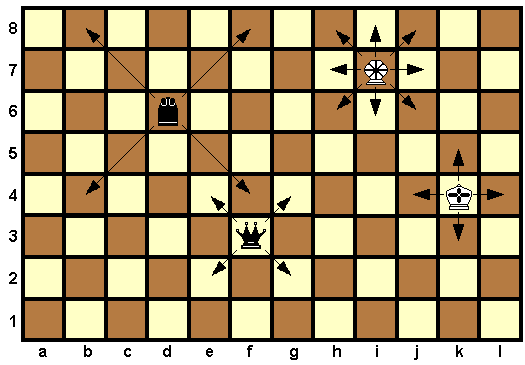
![]() Pawn: moves 1 step ahead if this square is empty, and takes
1 square diagonally ahead, just like its modern Chess
counterparts. No rules have been recorded as far as Pawn
promotion is concerned. Murray (1913) conjonctured that they
made have been identical to the rules in use for Chess in Germany
at the time of Selenus (1616): the Pawn had to return to his
original square by means of three "joy-leaps" (from
8th row to 6th, 4th and 2nd rows on the same file before it can
receive promotion to Queen)
Pawn: moves 1 step ahead if this square is empty, and takes
1 square diagonally ahead, just like its modern Chess
counterparts. No rules have been recorded as far as Pawn
promotion is concerned. Murray (1913) conjonctured that they
made have been identical to the rules in use for Chess in Germany
at the time of Selenus (1616): the Pawn had to return to his
original square by means of three "joy-leaps" (from
8th row to 6th, 4th and 2nd rows on the same file before it can
receive promotion to Queen)
The Pawn initial double step was not allowed. Instead, an "advanced" position was normally used to start the games where 3 particular Pawns (those of Rooks and Queen) where placed 2 steps ahead and where Queen was also placed two steps ahead as illustrated here:
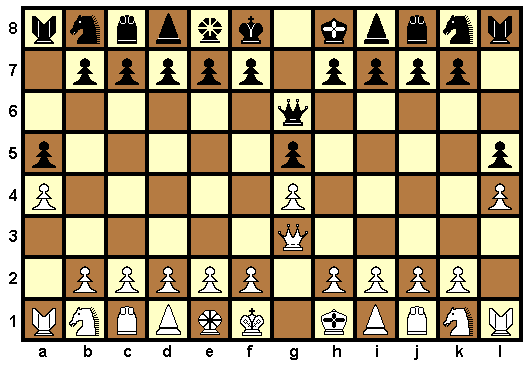
Advanced setup
REMARK:
The Courier was really a novelty for German Chess players who were then playing the Bishops with old limited move coming from Shatranj, a diagonal jump at the 2nd square. Naturally, that new piece gave its name to the game. The contemporary players were not used to visualize the diagonals on their length and believed that this so surprising piece was surpassing the Rook in strength.
HISTORY:
This special Chess game has a surprising rather long history, mostly confined to Germanic lands.
Between 1204 and 1209 appeared the Wigalois (The Knight of Fortune's Wheel), a German Arthurian romance by Wirnt von Gravenberg, inspired by French "Li bel inconnu" from Renaud de Beaujeu. In this text, Chess has been replaced by Courier Chess which is the very first mention. This variant was played in Germany on a 12x8 chessboard with 48 pieces.
A second appearance is a short mention in Schachbuch, a poem from Heinrich von Beringen, completed between 1290 and 1300. There, it briefly alluded to the Couriers as an imporvement of Chess.
In 1337, the Schachzabellbuch, a long poem was composed by Kunrat von Ammenhausen. In this text, the author affirmed to have seen Courier Chess played in Konstanz (Constance) and he listed the pieces added to the standard set.
Around 1510 was painted The Chess Players by the Dutch master Lucas van Leyden. Then, Courier Chess has been recorded for posterity!
In a chapter of his book, Das Schach- oder König-Spiel, published in Leipzig in 1616, Augustus, Duke of Brunswick-Lüneburg (1579-1666, known under the pseudonym of Gustavus Selenus), described three sorts of Chess played in Ströbeck. One of them was Courier Chess (along with medieval and modern games) and this is the account giving all the rules transmitted to us.
On May 13, 1651, Courier Chess, as well as standard Chess, were presented by the village of Ströbeck to Elector-Prince Frederick William of Brandeburg. It is this board that remains in Ströbeck and is shown above.
In 1661, Courier Chess was again represented by Jan de Bray, a classic Dutch Artist in Haarlem, Netherlands. In this sketch, several pieces show some resemblance to those painted by van Leyden.
Courier Chess sketched by Jan de Bray (possibly a self-portrait)
It seems that the game was not in use anymore for the beginning of the 19c. Lucas van Leyden's painting had a tumultuous history: it was hosted in the Königlihes Museum in Berlin. In 1945, it was sent to safety outside of Berlin on one order from Hitler. General Patton's army found it along with many treasures in a salt mine few months later and the painting was sent to USA, in National Gallery of Art in Washington. In 1948, it has been returned to Germany. It is now in the Staatliche Museen zu Berlin, Preußischer Kulturbesitz Gemäldegalerie.
RENAISSANCE:
Several attempt have been made to modernize Courier Chess with modern rules. One has been proposed by FIDE Master Paul V. Byway. A description and some annoted games can be found on this link.
Much before this date, a "Courier-Spiel" was proposed by H. G. Albers from Lüneburg in 1821. It is described on this link.
Another manner of making a new birth for this game was to reconstruct it. This was brightly done by Rick Knowlton who made a replica after a deep study of van Leyden's painting. This replica is available and sold on this wonderful dedicated web site: http://courierchess.com/.
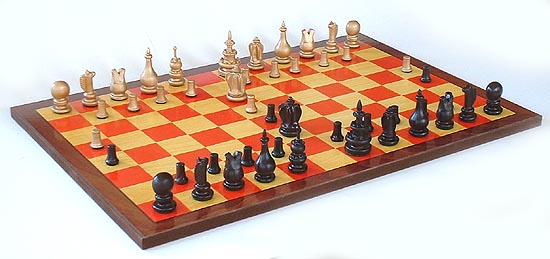
The
re-birth of Courier Chess: the game can start!

Set of pieces designed and sold on http://courierchess.com/

Starting
array of white pieces
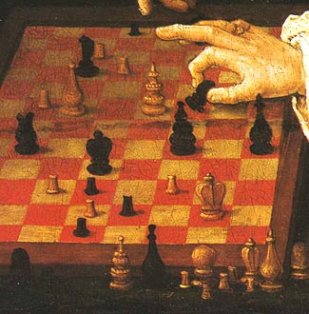
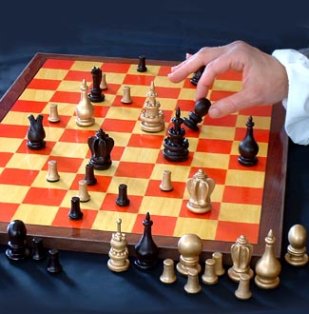
The game painted by Lucas van Leyden can now be pursued up to its end!






